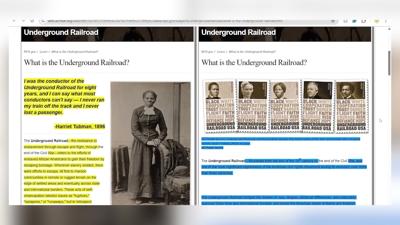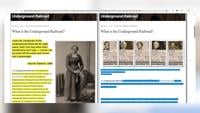CAMBRIDGE, Md. - Prominent references to Harriet Tubman were removed from the National Park Service’s webpage about the Underground Railroad — but as of 6:30 p.m. Monday evening, the agency has restored the website and re-imported the information that had been removed.
An archived version of the website from late January featured a quote from Tubman at the top, accompanied by her photo. In contrast, the version of the page that appeared earlier Monday opened with commemorative U.S. Postal Service stamps honoring those who escaped or helped others escape slavery. Tubman, the Underground Railroad’s most famous conductor, was then placed in the center of the page.

Yellow - Original, Blue - Updated
These changes followed broader modifications made to several government websites under the Trump administration. A comparison of the two versions showed that the edits were hard to miss.
Alex Green, a tour guide for Underground Railroad tours and director at the Harriet Tubman Freedom Center, criticized the changes.
"And now we're going backwards. There's been so much progress. This much effort to erase this critical time in history is only going to cause more problems in the future," says Alex Green, the director with the Harriet Tubman Freedom Center and a tour guide with the Underground Railroad tours.
Further down the earlier version of the updated webpage, several references to enslaved people as “freedom seekers” and mentions of the Fugitive Slave Act of 1850 had also been removed.
In a statement to WBOC, the National Park Service defended the edits.
"The idea that a couple web edits somehow invalidate the National Park Service’s commitment to telling complex and challenging historical narratives is completely false and belies the extensive websites, social media posts, and programs we offer about Harriet Tubman specifically and Black History as a whole. The focus on one webpage is dismissive of the hard work that National Park employees put in every day to preserve local history, safeguard special places and sharing stories of American experiences. We take the role we’ve been entrusted with seriously and can point to many examples of how we tell nuanced and difficult stories about American history.”
The agency also noted that hundreds of individuals have access to make edits to the site.
Still, some remained concerned about the motivation behind the changes.
"What was the intention of doing that? You know, if you see the track record of why they're doing things and how it seems as though they want to sweep history — or sweep the things that they don't want the public to embrace — under the carpet, then I think it's incredibly wrong," says local artist Michael Rosato, who has painted several murals of Harriet Tubman around Cambridge.
The National Park Service maintains that dozens of other pages continue to tell the story of Harriet Tubman.
The webpage now reflects its original layout and content, as it says, towards the bottom, Last Updated: April 7, 2025.
It includes the references to Tubman, enslaved people, and key events in Underground Railroad history.






